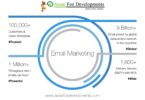All email marketers or bulk email service customers are aware of or should be aware of the significance importance of building & maintaining a highly engaged subscriber list. By sending relevant content at the right time to the right people who actually want to receive your email, that’s how you decrease the feasibility of emails being filtered to the spam folder – which in return increases your ROI Return On Investment. The criteria mailbox providers or ISPs use to determine who is an “engaged subscriber” has historically been a grey area, but now we have a much better idea of what metrics mailbox providers or ISPs consider important.
Each mailbox provider is unique in their SPAM filtering rules, but we do know that they all factor subscriber engagement into the equation one way or another. As would be expected, Gmail, Hotmail, Rediffmail, Microsoft, AOL, and Yahoo are industry leaders and know as biggest ISPs when it comes to evaluating engagement metrics for their SPAM filters. When they look at engagement, they focus on specific patterns of certain sending IP addresses and domains used to send emails. For example:
- Of the email being sent from this IP address, what is the ratio of emails sent to real accounts vs. test accounts?
- How active are the real accounts that are being sent to? Are these subscribers frequently logging into their account and interacting with the emails they receive? Reading them? Responding to them?
Hand in hand with these patterns, mailbox providers/ISPs are also closely monitoring the individual engagement metrics, both positive and negative. Positive engagement metrics include (but are not limited to) emails read, emails replied to, TINS – This is Not Spam votes and sender domain added to address book. On the other hand, a very telling negative engagement metric is a TIS – This is Spam vote. A This is Spam vote, often referred to as a “complaint,” is an extremely strong negative signal to the mailbox providers that the email sent was unwanted and has no business in the subscriber’s inbox.
Knowing how mailbox providers factor engagement into their SPAM filtering decisions gives you a step up on your competition.
However, what you do with this information is even more important.
How do you make sure that the emails you are sending to your subscribers are encouraging for opens, reads and clicks, rather than SPAM complaints?
Send emails that are designed to engage
An engaging & clean subject line can do wonders without adding many symbols. If you can grab your subscriber’s attention and pique their interest with a stronger subject line, you increase the feasibility that they will open your email and engage to your email. You spend a lot of time designing content that renders well across devices, so make it count!
example email:
Some online grocery store sent an email to me with a timely and compelling subject line. Scrolling through my email on my phone, I read “Limited Offer, Unlimited Savings: 10KG FREE Basmati, Flat 25% Off on Fruits & Vegetables Coupon FRESH25, Cooking Oil – Buy 1 Get 1 FREE” while I was in the home and thinking to go for grocery shopping, that weekend. How timely!
Once I opened the email, the email was well designed and continued the clever grocery store theme to highlight their free shipping and 30% off on all grocery bills.
Send emails that align with your subscriber’s interests
It’s important to understand subscriber behaviour and make sure that your emails align to their interests. Let’s say (hypothetically, of course) that I just spent a grossly amount of money on a expensive mobile for me, if you wonder how?, check this post named Can you get a loan with no credit. Let’s also say that I received three follow-up emails after my purchase from the same website.
Normally, I wouldn’t mind this and would even consider it a best practice. I just made a purchase and I’m engaged with that website or brand, so it also makes sense that they would try to hit the iron while it’s hot and keep me engaged. But unfortunately, all the emails they sent me were promoting other mobiles only! Now, it is very unlikely that they think I am still in the market for purchasing a mobile after purchasing from them only.
A better approach would have been to highlight on mobile accessories items that they sell, such as headphones, bluetooth, memory cards, etc. In fact, it was such an irritating experience, I ended up unsubscribing from their email program – a reaction which could have been avoided easily. If they had sent more relevant emails that made sense for where I was in the subscriber lifecycle.
When it comes to maintaining an engaged subscriber list, the first step is understanding how mailbox providers factor engagement patterns and metrics into their SPAM filtering methodology. From there, having a strong understanding of subscriber interests and lifecycle can help any email marketer or ESP Email Service Provider create engaging content that keeps their subscribers eagerly waiting for more.







